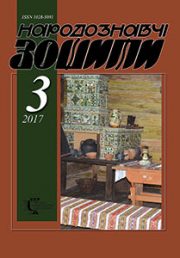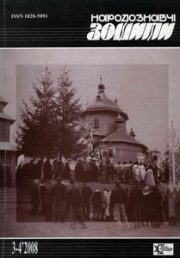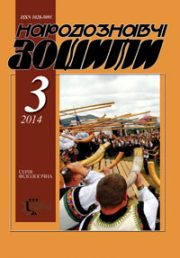The Ethnology Notebooks. 2023. № 1 (169), 44—57
UDK [[392.8/.86:641.564/.568]:316.47](477.86-11)
DOI https://doi.org/10.15407/nz2023.01.044
FOOD IN A FAMILY HOUSEHOLD AND CALENDAR RITUALS ON POKUTTIA
TARAS Yaroslav
- ORCID ID: https://orcid.org/0000 – 0001-7241-9466
- Doctor of Historical Sciences, Professor,
- Institute of Ethnology of the National Academy of Sciences of Ukraine,
- Head of the Modern Ethnology Department,
- 15, Svobody Avenue, 79000, Lviv, Ukraine,
- Contacts: e-mail: etnomod@ukr.net
Abstract. The article examines the national food of Pokuttia, the factors on which it was based and which determined the appearance of this or that dish, its consumption throughout the year, and the impact on the family life and character of Pokuttia. It was found that it depended on the economic direction, it was influenced by the economic policy of the state and the region, the Church, urbanization, the small nobility, and the lack of agricultural products. Meals on weekdays, Sundays, holidays, fasts and butchers are covered.
It was found out how cereals, buckwheat, millet, cereals, vegetables, and meat were used in food. The storage of products, the range of dishes and their preparation is presented in article.
In order to establish how nutrition was formed in Pokuttia, crop rotations at the beginning of the 20th century were analyzed.
The agricultural crops that were grown in Pokuttia developed local traditions of a vegetarian nature and etiquette during the preparation and consumption of food. It was established that the shortage of products led to strict regulation of their use during the year.
It was also found that nutrition affected the character of Pokuttia people, family relations, created role, gender and age differentiation in the family.
Food in Pokutta is one of the markers that makes it possible to relate oneself according to its unique characteristics to a certain territory, which differs from neighboring historical and ethnographic communities and territories, makes it possible to identify oneself with this territory.
Keywords: Pokuttia, Snyatynshchyna, Kolomyshchyna, nutrition, food, folk cooking, folk food, vegetarian food, bread, milk, meat, porridge.
Received 29.01.2023
REFERENCES
- Mrochko, Fr. K. (1977). Snyatynshchyna: Reasons for regional ethnography (Part 1). Detroit [in Ukrainian].
- Kolberg, O. (1882). Pokuttia. Ethnographic Image (Vol. 1). Krakow: Printing house of the Jagiellonian University Obraz etnograficzny (Vol. 1). [in Polish].
- Hnatyuk, V. (1899). Folk food and its seasoning method in eastern Galicia. Materials for Ukrainian-Russian ethnology (Vol. 1, pp. 96—110). Lviv: NTSh [in Ukrainian].
- Golubovych, I. (1918). Folk food in Snyatinsky District (Pokutye). Materials for Ukrainian ethnology (Vol. XVIII, pp. 48—70. Lviv: NTSh [in Ukrainian].
- Voloshynsky, I. (1919). Wedding in Daleshev, Horodensky district. Materials for Ukrainian ethnology (Vol. XIX—XX, pp. 2—34). Lviv: NTSh [in Ukrainian].
- Golubovycheva, O. (1919). Wedding in the village of Ilyntsy, Snyatyn district. Materials for Ukrainian ethnology (Vol. XIX—XX, pp. 177—193). Lviv: NTSh [in Ukrainian].
- Gontar, T.O. (1979). Folk food of the Ukrainian Carpathians. Kyiv [in Ukrainian].
- Gontar, T.O. (1987). Food. Hutsul region Historical and ethnographic research (Pp. 203—217). Kyiv: Naukova dumka [in Ukrainian].
- Artyukh, L.F. (1977). Ukrainian folk cooking. Kyiv [in Ukrainian].
- Klodnytskyi, O. (1975). Folk life, customs and folklore of Tovmachyna. Almanac of the Stanislavsky land. A collection of materials for the history of Stanislavov and the Stanislav region (Pp. 876—888). New York; Toronto; Munich [in Ukrainian].
- (1988, 2008). Kolomyia and Kolomyyshchyna. A collection of memoirs and articles about the recent past (Vol. 1, 2). Philadelphia [in Ukrainian].
- (1978, 2002). Horodenshchyna Historical-memoirs collection (Vol. 1, 2). New York; Winnipeg; Horodenka [in Ukrainian].
- Bazhansky, M. (1982). The beauty of the Snyatyn Region: rivers, streams, forests, meadows, gardens, cities and villages and the material and spiritual culture of their inhabitants: Encyclopedia. Detroit [in Ukrainian].
- Solyanych, D. (2004). Who is to blame?: Stories, letters. Sniatyn: PrutPrint [in Ukrainian]
- Snyatinchina. Historical and ethnographic naris. Snyatin; Ivano-Frankivsk; Lviv: Manuscript. 2014. 732 с.
- Borenko, N. (2013). Local features of folk food in the 20th century on the border of Hutsul region and Pokuttia. Folk creativity and ethnology, 6, 37-48 [in Ukrainian].
- Sapeliak, O. (2017). Nutrition of Pokutians. Ethnological notebooks, 1, 136—153 [in Ukrainian].
- Artyukh, L. (2006). Traditional Ukrainian cuisine in the folk calendar. Lviv: Baltiya-Druk [in Ukrainian].
- (2021). Ukraine. Food and history. Kyiv: Yzhak [in Ukra inian].
- Cream, L. (2009). Galician nobility in Austria-Hungary (1772-1914). Ivano-Frankivsk: City of NV [in Ukrainian].
- Monolatius, I. (2010). Tsarskoye Kolomyia 1772—1918. A drama in three acts from the life of the second city of Galicia during the Habsburg era. Ivano-Frankivsk: Lileya-NV [in Ukrainian].
- (1908). Handbook of statistics of Galicia (Vol. 9, part 1). Lviv [in Polish].
- (1939). Agricultural statistics 1938. Warsaw: Central Statistical Office[in Polish].
- Franko, I. (1980). Materials for studying the language and ethnography of the Ukrainian people. Collection of works: in 50 t. (Vol. 26, pp. 180—204). Kyiv [in Ukrainian].
- Commune Index of Galicia, compiled on the basis of the results of the census of December 3, 1900, issued by the Central Statistical Commission (Vol. 12). Wieden [in Polish].
- IF ODA. F. P-1576. Op. I. Od. save 309. Arc. 11—12 [in Ukrainian].
- (1867). Universal Encyclopedia (Vol. 24). Warsaw [in Polish].
- Velikochy, V. (2014). Traditional Pokuttia holidays of the New Year cycle and their use in the modern tourism industry of the region (Part 24—25, pp. 279—286). Yamhoriv [in Ukrainian].







